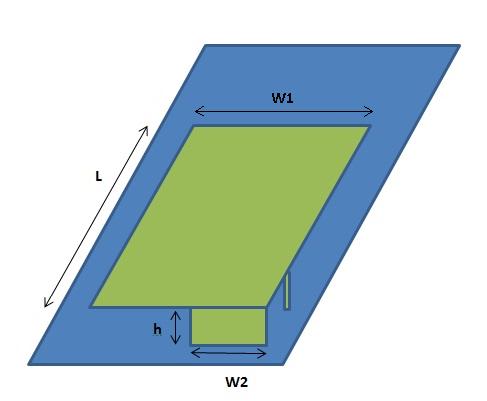A Planar Inverted F Antenna or PIFA is a very common antenna type being used in cell phones. In fact a cell phone would have multiple PIFAs for LTE, WiMAX, WiFi, GPS etc. Furthermore, there would be multiple PIFAs for diversity reception and transmission. A PIFA is composed of 5 basic elements.
1. A large metallic ground plane
2. A resonating metallic plane
3. A substrate separating the two planes
4. A shorting pin (or plane)
5. A feeding mechanism

The resonant frequency of the PIFA can be calculated from the relationship between the wavelength of the antenna and the dimensions of the antenna. The relationship is given as:
L+W1-W2=λg/4
It must be remembered that the wavelength here is the guided wavelength which is given as λg=λo/√εr. Here εr is the relative permittivity of the substrate and λo is the wavelength in free space. There exist two special cases of the above relationship. First is the case where the shorting plane has width W1. In this case the above relationship is reduced to:
L=λg/4
In the second case the width of the shorting plane is reduced to zero i.e. the shorting plane is actually a shorting pin. In this case the relationship is reduced to:
L+W1=λg/4
In cell phones with multiple PIFAs the ground plane is actually one large ground plane for all the resonating surfaces and may include the body of the cell phone as well. Lastly, the input impedance of the PIFA is controlled by changing the distance of the feeding pin from the shorting plane. The impedance is zero at the shorting plane and is maximum at the other end (away from the shorting plane).
Reference
[1] http://www.antenna-theory.com/antennas/patches/pifa.php
Author: Yasir Ahmed (aka John)
More than 20 years of experience in various organizations in Pakistan, the USA, and Europe. Worked as a Research Assistant within the Mobile and Portable Radio Group (MPRG) of Virginia Tech and was one of the first researchers to propose Space Time Block Codes for eight transmit antennas. The collaboration with MPRG continued even after graduating with an MSEE degree and has resulted in 12 research publications and a book on Wireless Communications. Worked for Qualcomm USA as an Engineer with the key role of performance and conformance testing of UMTS modems. Qualcomm is the inventor of CDMA technology and owns patents critical to the 4G and 5G standards.